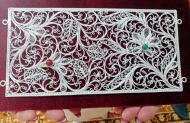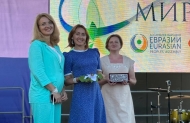
On 29 June 2024, the Eurasian Peoples’ Assembly together with its partners - the Centre for Social Technologies "Dealing with Meaning" - gave a solemn start to the International creative action "Belt of Peace". It was held on the day of the 95th anniversary of the Vacha Municipal District of Nizhny Novgorod Region. This very land became an inexhaustible source of inspiration and a place of training for the participants of the “Eurasia Heritage: Rural Communities” project, which ended in May 2024. The idea of the action was born in the process of the project implementation and became its logical continuation.
The Belt of Peace campaign is aimed at popularizing crafts and cultural codes of the territories, facilitating the formation of sustainable ties between the participants of the campaign in different regions and countries, helping to preserve traditions and unite people at the level of cultural values.
Giving a start to the action, in her video message, Svetlana Smirnova, Chairperson of the General Council of the Eurasian Peoples’ Assembly, noted:
"Rural communities are the foundation of our future. They need to be developed - they are the essence of our strength. And strengthening vertical and horizontal ties, in my opinion, is the most important task.
I am very glad that the international project "Eurasia Heritage" gave an impetus to unite craftsmen from different regions of Russia and countries of the world. And in the process of its implementation, new ideas were born. They formed the basis for the next project, which we are launching today with the "Belt of Peace" action.
I am confident that our joint work will make a significant contribution to building a sense of awareness of our cultural roots and, at the same time, global unity.
I am pleased to announce the official start of the international action "Belt of Peace"! I wish successful development of the project and your wonderful Vacha land, which has united masters of folk art around itself!".
Participants of the "Belt of Peace" action - masters of arts and crafts and folk arts and crafts - create parts of a decorative accessory - a belt that demonstrates the cultural codes of the territory and represents the handicraft traditions of their native land.
The first part of the symbolic belt was made at the art products enterprise in the village of Kazakovo, Vacha Municipal District, Nizhny Novgorod Region. The masters work in the filigree technique. This is the most ancient type of metalworking, which is used to create elegant products with a pattern of smooth or twisted wire. The second link of the belt is made by Sochi masters. It is a textile plate with a three-dimensional image of the Sochi magnolia. And the start of the action was the solemn joining of the first two links of the future "Belt of Peace" on the day of celebration of the 95th anniversary of Vacha municipal district of Nizhny Novgorod region.
Representatives of 5 regions of Russia came to the solemn presentation of the international action and participants of the international project "Eurasia Heritage: Rural Communities" from Azerbaijan, Kazakhstan, Kyrgyzstan, as well as from Penza, Samara, Sverdlovsk regions of the Russian Federation and the Republic of Sakha (Yakutia) sent their video greetings.
Sergey Lisin, the Head of Vacha Municipal District, speaking at the presentation of the international action "Belt of Peace" said that during the formation of the cultural artefact will be in the local museum, but then it will travel to international exhibitions and events as a symbol of the life journey of representatives of different ethnic groups, united by the idea of peace and community.
The international action "Belt of Peace" as well as the previous project of the Eurasian Peoples’ Assembly and the Centre for Social Technologies "Dealing with Meaning", dedicated to cultural practices of rural communities, will be aimed at promoting the development of rural areas of the Eurasian space and expanding the potential of partnerships of local communities in the preservation and development of cultural heritage.






